
 US Navy Attack Submarines (SSK) 1949-1984
US Navy Attack Submarines (SSK) 1949-1984Cold War US Subs
GUPPY | Barracuda class | Tang class | USS Darter | T1 class | X1 class | USS Albacore | Barbel classUSS Nautilus | USS Seawolf | Migraine class | Sailfish class | Triton class | Skate class | USS Tullibee | Skipjack class | Permit class | Sturgeon class | Los Angeles class | Seawolf class | Virginia class
Fleet Snorkel SSGs | Grayback class | USS Halibut | Georges Washington class | Ethan Allen class | Lafayette class | James Madison class | Benjamin Franklin class | Ohio class | Colombia class
The Tang class submarines were the first generation postwar diesel attack submarines. Unlike the K class which were prototypes for a wartime simplified “ambush submarines”, the Tang class were fully-grown attack submarines integrating as many lessons from the U Boat Type XXI as possible. They were the cradle of many innovations in the US Navy, with a new streamline hull and sail, and new compact “pancake” diesels which proved unreliable however and had to be changed rapidly. With their Fairbank-Morse diesels (which necessitated to lenghten them up) they were modernized and “jumboized” a second time in the 1970s to adopt the new PUFF Sonar system. Some saw service with other nations almost until the 1990s (Italy and Turkey) which is quite remarkable for 1950s first generation SSK… https://naval-encyclopedia.com/cold-war/us/tang-class-submarines.php #usnavy #usn #tangclass #submarines #submarine #SSK #pancakediesels #typeXXIuboat
Origins of development
1945 saw the USN obtaining several U-Boats, and only retained the most interesting, a Type XXI though tested and close examination of U-2513. This revealed through a secret report sent to the CNO in July 1946 enriched by testimonies of former commander Erich Topp. The team sent aboard for trials was surprised by its underwater top speed on electric power, longer underwater autonomy, a bit less by the shortcomings of her snorkel, but advantage of plugging just one diesel to charge the batteries while partially submerged. Besides performances, other innovations were noted like the exceptional periscope optics, top of the line passive sonar estimated way above USN standards, and were amazed by the hydraulically operated torpedo-handling gear in the bow, enabling a full reload in five minutes withou human intervention, on a button push.
In drydock, this was more constrasted, with good points such as the thickness and strength of her pressure hull giving an estimated limit to 1,500 feet, twice as much as for a Gato class. They also noted U-2513 automatic pilot for precise direction underwater at high speeds.
They were however appealed by her grave manufacturing faults, structural integrity and weak assembly of the modules, as well as weakly built, unreliable diesel engines and faulty superchargers as well as an unreliable hydraulic system, way too delicate as designed to withstand a depht charge schock. They also noted saltwater leakage and corrosion.
However in the end, these were all pointing out a type of submarine that was way ahead any known standards at the time, “the future” as concluded by the evaluation commission. All agreed than the next class would have to integrate all these good points, including the streamlining, but dropping others that seems too complicated like the automated torpedo reload ad remote AA armament. As it would take time to design a brand new model, and the Congress was not too happy about voting it when the USN still had a bounty of perhaps 150 recent subs of the Gato/Tench/Balao class, some completed in 1945. The other point was the fear of Soviet intel, which already acquired at least one another Type XXI, and expected mass construction of these. So the response was two fold: Convering exiting subs, as the GUPPY I, II, III and sub-variants in between preparing, voting and building a brand new design. The conversion was cost effective and a quick solution to bolster the US sub fleet, updating the “fleet snorkel” while the admiralty was busy working on a new design. The complexity looked for however grew as a concern, and delays to create this new class led to another idea of an “interim type”, a dumbed down submarine class that would be cheaply mass produced in order to ambush Soviet subs coming out from their bases. These simplified models were called “Project Kayo”.
They would ultimately led to the construction of three prototypes of the K class, later called the Barracuda class. These midget subs were to be mass-produced in case of war, which never happened. Overall these models were not very successful and the program was later cancelled. Meanwhile the admiralty worked on a larger, more refined type that would integrate as many features from the Type XXI as possible.
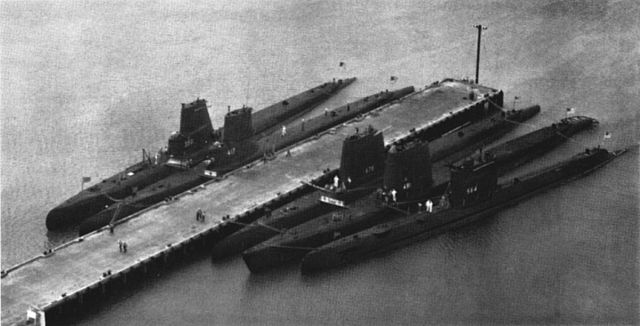
Tang and GUPPY II class subs at NS Roosevelt Roads, PR, c1965.
Design
Design Genesis
The Type XXI deeply troubled the naval staff, knowing thy would be able to get away after attacking a fast battlegroup with some good chance of success and that the Soviet Navy took nearly fifteen of the Type XXI in construction of recently completed on their sector, and the lingering question was about one design or separate ones for separate missions. In August 1945 Commodore Merrill Comstock, the new, CNO launched a study of based on submariners reports, which ended with a discussions between the General Board and Submarine Officers. They advocated for a single design built in 1946 and conversions for specialized uses, with the new sub design process officially starting in February 1946.
It was obvious at first the new model will have a streamlined hull and conning tower, with bridge and masting support enclosed in a light faired structure, the “sail”. It was recoigniese that underwater, the older boat’s own structure caused a drag costing up to 50% of the speed loss. Everything was made retractable, deck guns eliminated, and a circular section hull chosen which in some ways was even more radical than the German Type. The pressure hull was a bit wider too, with a better steel and a radical new engine was looked for.
General Motors proposed indeed to the Navy its new lightweight compact engine “pancake” to provide high speed. With its vertical crankshaft and radial cylinders the GM 16-338 were just 13.5 feet high and 4 feet wide. Two cycle, they developed 1090 bhp at 1600 rpm for eight tons enabling engineers to make a 22 feet long engine room.
Even more space was reclaimed by the elimination of the four aft tubes, but this was reclaimed back by sub officers. A compromise with two 21″, 15 feet long tubes was found firing the Mk-27 and planned Mk 37 torpedo, usable only as countermeasure at pursuing ASW ships or hunter submarines. These new lightweight, compact tubes were designed for swimout type torpedos.
The tubes forward used for the first time a slug of water, with an air powered piston pushing water like an hypodermic needle. The sea valve was closed and when firing, the procedure was to mount the pressure of air in the aft end of the piston, pressurizing water until the slide valve (with ports around the torpedo tube= opened, allowing water from the piston to enter the tube aft end, which forced the torpedo out without air bubbles and quiet noise. By October 1946, the design was finalized, two boats ordered, USS Tang (SS-563) at Portsmouth Naval Shipyard and USS Trigger and at Groton, in the reputed old Electric Boat yard (Holland’s company). Thus following the tradition of naming subs from fishes, this became the Tang-class. By FY47 two more were ordered (Wahoo and Trout) and by FY48, Gudgeon and Harder, with a construction started a bit later but which proceeded and concluded on time, Trigger being first. It’s in sea trials that problems soon emerged…
A new hull for greater agility and depth
Probably the most important innovation of the Tang class was their test depth increased from 400 ft (120 m) to 700 ft (210 m) using the now well known and used High Tensile Steel (HTS, compressed and hardened at 42,000 psi (290 MPa) yield strength). This still was a far cry to the Type XXI test depht, but at least it allowed to take advantage of deeper ocean to evade sonar and gave more room for manoeuver.
The search for an innovative powerplant
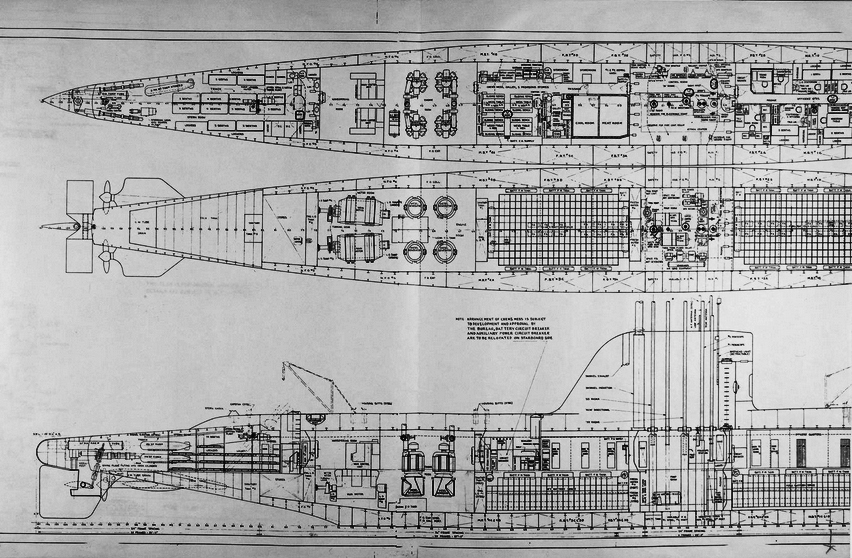
Tang class, partial plans src
Another innovative point, was their brand new General Motors EMD 16-338 which were lightweight, compact and high-speed “pancake” type engine. They were rated at 1,000 bhp each. Very different from classic diesels they had instead of an horizontal crankshaft, a vertical one with cylinders arranged radially like in an aircraft engine. These engines were 13+1⁄2-foot-tall (4.1 m), 4-foot-wide (1.2 m) and weight eight-ton each, being compact enough to fit instead a relatively short, single engine room instead of a whole compartment. They were composed of an air intake, four layers of four cylinders each, each having a six inch bore, 6-1/2 inch stroke and at the bottom of the crank shaft was an Elliot generator (817 kW at 710 volts DC).
This freed much space and enabled to reduce overall length for a more agility-wise type of hull compared to previous fleet snorkels. These were a bit taller, but shorter, based on the belief this would made them much more maneuverable and especially underwater, due to less submerged drag. To go with the new engines (which proved unreliable) were aded four compact Guppy-type 126-cell lead–acid batteries to reach the desired submerged speed, up to 25 knots (46 km/h). Some planned an evolution of an adaptation of the Type XVII U-boat hydrogen peroxide turbine model, which was a closed-cycle diesel system, and a small faction led by Hyman Rickover pushed for the adoption of nuclear power. However both the Pancake engines and AIP diesels soon proved unsuccessful, and nuclear power at that stage was too experimental and too large to fit in a Tang-class hull anyway.

Hull 3/4 fwd 3d view

Prow, still boat like with side tubes openings

The streamlined, tall conning tower

The hull, seen from front, showing the streamline hull broken by the chin-mounted active sonar.

Stern, still with the winged propeller shafts. USS Gudgeon SS 567 by RickDEllis on 3DOcean.
In the end, the new submarine had a displacement of 1,560–2,050 long tons (1,585–2,083 t) surfaced, 2,260–2,700 long tons (2,296–2,743 t) submerged, comparable but lighter than previous boats. The hull measured 268 ft (82 m) originally, which was indeed shorter than previous GATO types. After jumboisation (swap to a new powerplant) however it was stretched to 277 ft (84 m) and then to 292 ft (89 m) for the same beam of 27 ft (8.2 m) and Draft of 17 ft (5.2 m). They had more draught, but less width (vs. 8.30 m on the Gato), reverting from a 1/11 to a 1/10 hull ratio.
Another point was the shape of the hull, which was far more streamined and worked in detail to achieve the best hydrodynamic results.
The conning tower for example was based on tests made with Gato class subs and of the “sail” type, full and tall.
Complement was 8 officers, 75 enlisted, a bit less than in previous boats, due to greater automation.
Their hulls were rebuilt twice: Once for the first four after their sea trials, due to the inadequacy of the engines, replaced by larger ones which forced the addition of a 9 feet section, for an overall lenght of 277 feet.
In 1967, some were rebuilt once more, gived an additional 15 (some sources 18) foot section. The idea was to make room to receive new PUFFS installations. These were the SS 563, 565, 567 (Built in Portsmouth) and SS 568. Meanwhile the Guppy program reached a new level with the late GUPPY-III that could dive deeper than the Tangs. They ended nearly as good and way cheaper and so this explained why the Tang class was limited to six boats. Meanwhile foray into nuclear propulsion led b Rickover would lead to the completion of USS nautilus, and a few years after, to the Skipjack which introduced a brand new shaped hull, a combination that was a quantum leap in submarine capabilities, enduring to the present day. All this happened in the 1950s.
Propulsion
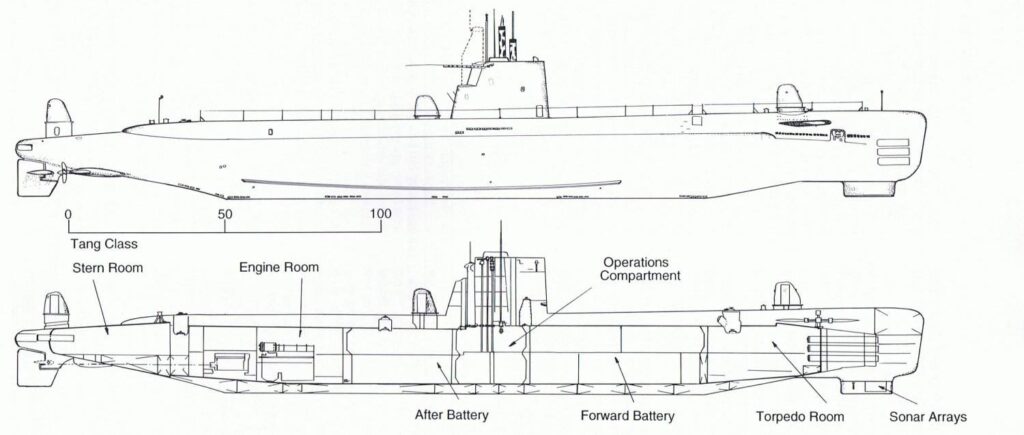
USS Tang cutaway and inboard profile, main deck and platforms during the 76/77 overhaul at Mare Island, end of their development (long hull) provided by Darryl L. Baker. (navsource)
In their initial configuration these boats sported four General Motors 16-338 “pancake” diesel engines (4,000 shp (3,000 kW) total). They proved totally unreliable, between vibration issues, and poorer output than expected, plus some maintenance issues. Trials of the early 1950s also revealed that the fact that they were compact and high-speed made them difficult to maintain. The vibrations caused them to overheat and leak oil into their generators, with potentially catastrophic consequences.
In short, these engines were just not adapted to submarine use. They supposedly were to use a special lubricating oil but the Navy supposedly insisted on standard diesel lubricating oil which affected the bearings. Another was the apparent lightness of their internal structures and the leakage became a real maintenance problem, especially in such cramped, confined space. The crews just hated them.
In 1956, so, the Navy decided to replace the engines with three ten-cylinder Fairbanks-Morse opposed-piston 38D 8-1/8 diesels similar to thos of 1945 Balao class boats, reworked and uprated from 1,350 shp (1,010 kW) to 1,600 shp (1,200 kW) each. Since these were larger engines, and no compromises could be made for the electric motors and batteries, that ate 1/3 of the pressure hull despite being one level lower, the boats had to be lengthened. In drydoc, they had a new section added (jumboised) of nine feet (2.75 m) in the engine room. These were three additional frames between frames 69 and 70. In 1957-1958 the whole first batch of four Tangs were lengthened this way, but Gudgeon and Harder still under slip were completed to this new standard and with their new engines. This propulsion plant was deemed successful and reliable, and was resued for all following US conventional submarines.
The three Fairbanks Morse 38D8-1/8 opposed piston engines (4,800 shp (3,600 kW) total) were still complemented by the same two electric motors rated for 4,700 shp (3,500 kW) total and four 126-cell batteries as said above, standard on GUPPY class. They had two shafts installed the same way as on classic boats, emering on either side and fixed through “wings”, part of the tail. Below was an articulated rudder.
Final top speed was 15.5 kn (28.7 km/h; 17.8 mph) surfaced, in line of even lesser than previous boats, but 18.3 kn (33.9 km/h; 21.1 mph) submerged which was the improvement looked for. Based on this, their range was 11,500 nmi (21,300 km) at 10 knots (19 km/h; 12 mph) surfaced, down to one hour at 17.5 knots (32.4 km/h; 20.1 mph) on battery. They can even maintain 18 knots for 1hr in the best of conditions, her endurance at 3knots was 43hrs (compared to 48 at 2 kts for the Gato class), and over 129nmi (96 on Gato). Test depth was 700 ft (210 m), not impressive compared to the Type XXI but deemed sufficient.
Armament
Nothing revolutionary on that chapter: The Tang class had essentially the same equipment that previous boats, with eight 21 inch (533 mm) torpedo tubes, six forward, and two aft, and a reserve of 26 torpedoes in all. Torpedoes at the time were likely the same models used on the GUPPY and K class, Mark 16 (Mod 3) 4,000 lb (1,800 kg), with a 746 lb (338 kg) Torpex or HBX (later used HBX-3) 960 lb (440 kg) Torpex (later used HBX) warhead and turbine (13,700 yd (12,500 m)). Later they wre upgraded to heavy torpedoes when the tubes were changed.
The Mark 33 for example (1949) were acoustic (passive) models which carried 550 lbs. (249 kg) HBX to 15,000 yards (13,710 m)/27 knots.
The torpedo tubes were redesigned during their initial 1955-56 refit. The six forward tubes were changed for air-powered piston ejection pumps. The latter forced a slug of water through a slide valve behind the torpedo, rather than a pulse of air. This made them quieter, without release or air bubbles and ombined to new deper diving electric (wake less) acoustic models, a true revolution was on the march. This combination was used in all subsequent submarine designs, including worldwide. The four stern tubes were reduced to two, shorter and simpler designed for the Mark 27 and planned Mark 37 swim-out torpedoes.
Thus, their bow tubes fired now the new standard heavyweight torpedoes of US subs: The 19″ (48.3 cm) Mark 37 and Mark NT37
Introduced in 1957 for the 1st generation, Mods 0 weighted 1,430 lbs. (649 kg) for 11 ft 3 in (3.429 m) in lenght. They carried a 330 lbs. (150 kg) HBX warhead, at either 10,000 yards (9,140 m)/26 knots or 23,500 yards (21,490 m)/17 knots. They were powered by an Electric-Battery and guided by an Active and passive acoustic sonar. Later versions had an Otto fuel engine and were Wire guided.
Sensors
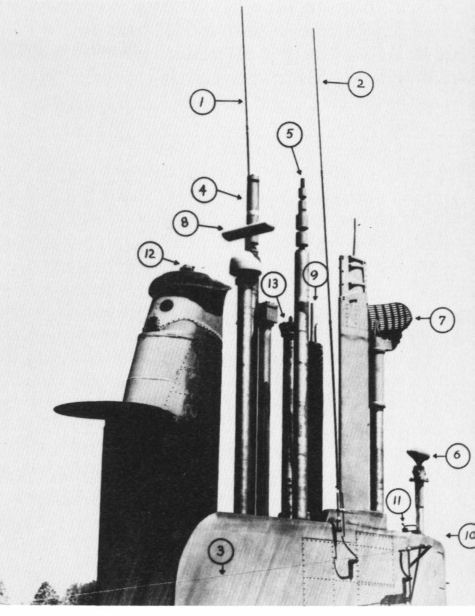
CT of USS Tang showing the different arrays and periscopes (navsource)
BPS-12 radar: The AN/BPS-12 is a medium-range pulse-only surface search and navigation radar on periscope mast. The BPS-12 is a modified BPS-5, similar to the BPS-14. Max range 74.1 km.
BQR-3 Sonar: Early type of passive cheap sonar, also shared by the GUPPY type. It should be noted that after their 1955-56 refit they all received also the APR-1 ECM suite and BLR-1 ECM suite.
BQR-4 sonar: Conformal passive array predecessor to the BQR-7 on Permit/Sturgeon class, an evolution added during upgrades, same type with more range.
BQG-4 PUFFS sonar: Installed only in USS Wahoo in 1964 and Gudgeon in 1967.
Construction
In October 1946, the first two were ordered, two more in 1947, and the last pair in 1948. All were named after US submarines lost during World War II in the Pacific.
USS Tang (SS-563) was from Portsmouth Naval Shipyard, laid down 18 April 1949, launched 19 June 1951, completed 25 October 1951. 1955 Refit, discarded 8 February 1980, Transferred to Turkey and decommissioned 2004 (museum)
USS Trigger (SS-564) was from Electric Boat, laid down 24 February 1949, launched 14 June 1951, completed 31 March 1952, discarded 2 July 1973 to Italy 10 July, decommissioned 28 February 1986.
USS Wahoo (SS-565) was from Portsmouth Naval Shipyard, she was laid down on 24 October 1949, launched 16 October 1951, comp. 30 May 1952. Decommission 27 June 1980, Scrapped 1984.
USS Trout (SS-566) was from Electric Boat, laid down 1 December 1949, launched 21 August 1951, comp. 27 June 1952, discarded 2 January 1977, transferred to Iran 19 December 1978 but rescinded March 1979, reserve 1979-92, USN sonar testbed 1994-2007, scrapped 2008.
USS Gudgeon (SS-567) was from Portsmouth Naval Shipyard 20 May 1950, launched 11 June 1952, comp. 21 November 1952, decom. 30 September 1983, transferred to Turkey 1983, decommissioned 2004, museum.
USS Harder (SS-568) Electric Boat, launched 30 June 1950, 3 December 1951, comp. 19 August 1952, decom. 31 January 1974, transferred to Italy 18 August, decommissioned, scrapped 1988.
Preservation
Two boats were preserved, TCG Pirireis (ex-Tang) and TCG Hizirreis (ex-Gudgeon) in Turkey at the İnciraltı Sea Museum in İzmir, and Hizirreis at the Kocaeli Museum Ships Command in Izmit.

USS Tang in its first configuration, compared to a GUPPY III (behind)
⚙ Tang class specifications |
|
| Displacement | 1,560–2,050 long tons surfaced, 2,260–2,700 long tons (2,296–2,743 t) submerged |
| Dimensions | 268* x 27 x 17 ft (82 x 8.2 x 5.2 m) |
| Propulsion | 2 shafts, 4x GM 16-338 diesels 4,000 shp, 2x electric motors (4,700 shp), 4x 126-cell batt. |
| Test depth | 700 ft (210 m) |
| Speed | 15.5 kn (28.7 km/h; 17.8 mph)/18.3 kn (33.9 km/h; 21.1 mph) |
| Range | 11,500 nmi (21,300 km)/10 kn surfaced, 1h/17.5 kn sub. |
| Armament | 8× 21 in TT (6 fwd, 2 aft), 26 torpedoes |
| Sensors | BPS-12 radar, BQS-4, BQR-2 sonars, APR-1 ECM suite |
| Crew | 8 officers and 75 enlisted men |
Read More/Src
Books
Friedman, Norman (1994). U.S. Submarines Since 1945: An Illustrated Design History. Annapolis, Maryland: United States Naval Institute. pp. 16–28, 242
Friedman, Norman (1984). Submarine Design and Development. Annapolis, Maryland: United States Naval Institute. p. 61..
Kocaeli Museum Ships Command Archived 2014-12-22 at the Wayback Machine
Blackman, Raymond V.B. Jane’s Fighting Ships 1971–72. London: Sampson Low, Marston & Co., 1971.
Gardiner, Robert and Chumbley, Stephen, Conway’s All the World’s Fighting Ships 1947–1995, London: Conway Maritime Press, 1995.
NavSource.org Postwar Diesel Submarines photo gallery index
Gallery
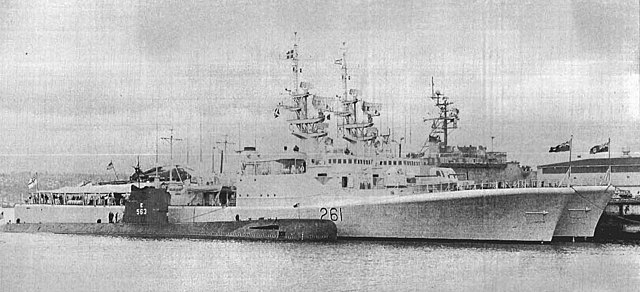
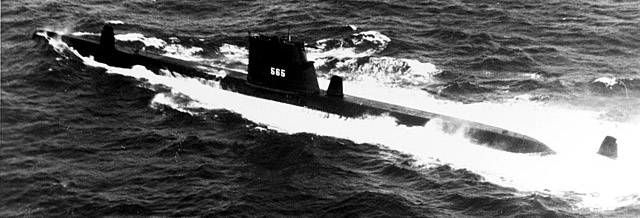
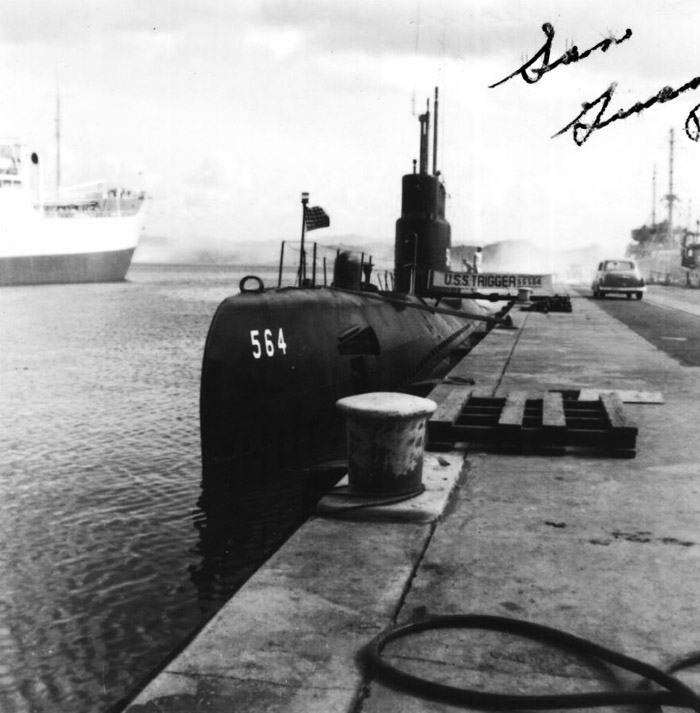
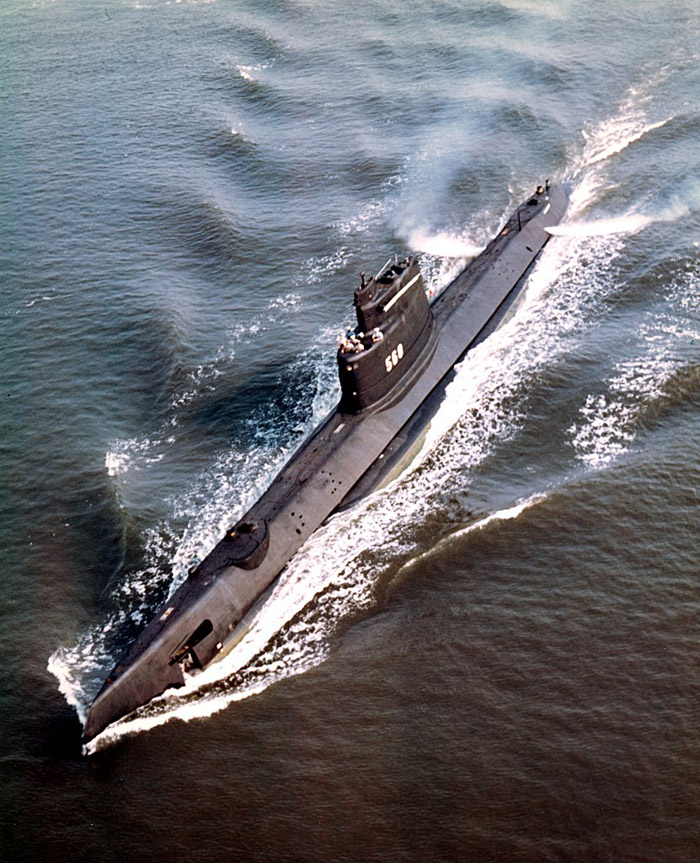
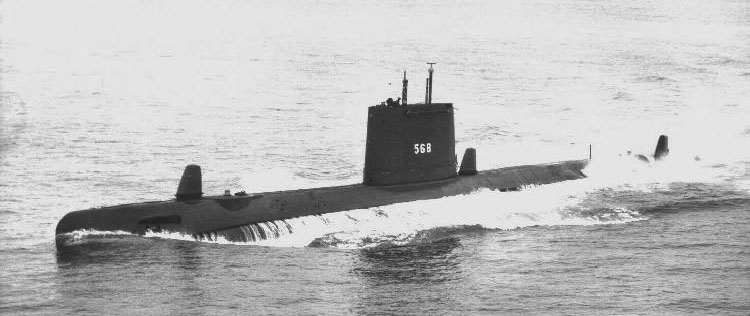
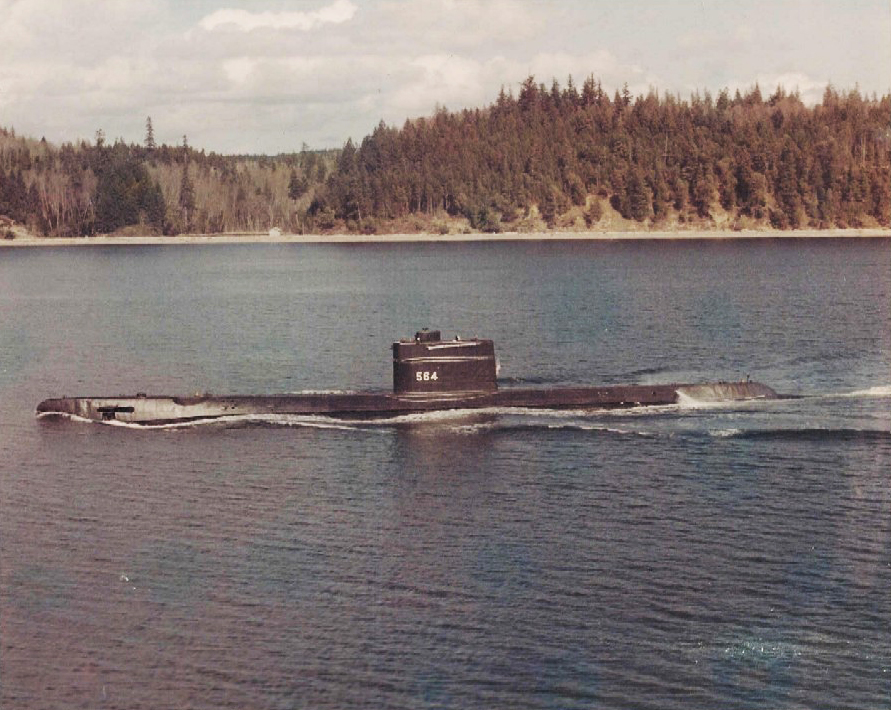

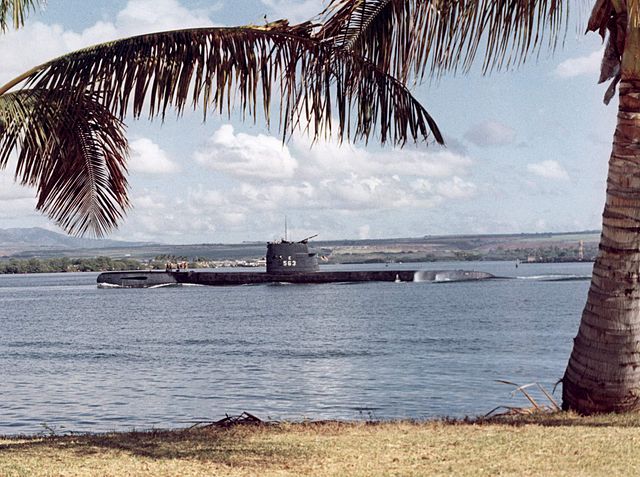
The Tang class in action
 USS Tang SS-563
USS Tang SS-563

Following trials and training along the east coast, USS Tang was assigned to Submarine Squadron 1 (SUBRON 1) of the Pacific Fleet, HP Pearl Harbor. After exercizes off the Hawaiian Islands, for ASW fleet training she was started her refit, from October 1953 (plus overhaul) completed in July 1954.
After refreshser training she made her first western Pacific deployment in September, ending at Pearl Harbor in March 1956. She operated off Hawaiian until June, then in Alaskan waters. Back to Pearl Harbor in August she started a second overhaul and modifications in in which she was jumboised and the powerplant modified, restarting service from 20 July 1956, for a second deployment in the western Pacific, making seven more until 1972.
At some point she hosted the Commander, Seventh Fleet, and trained with Japanese Maritime Self Defense Force, ROCN, and SEATO. She also had regular overhauls at the Pearl Harbor Naval Shipyard and by the spring 1958 rescued 5 CIA officers off the southern coast of Sulawesi, fleeing Sukarno’s army after the failed coup. She also cruised to at times the northwestern coast of North America (an entry point for soviet subs) and by March 1959 in one of these cold weather training cruise she tested a new snorkel de-icer system. She also provided services to the Naval Torpedo Testing Station at Keyport and RCAN at Esquimalt and again on the Pacific Northwest in late February 1961; Shs also took part in Fleet Exercise, SLAMEX.
By May-June 1964 she had another overhaul adn cruised along the west coast, but was soon called to Vietnam after the USS Maddox and Turner Joy Gulf of Tonkin Incident. From Pearl Harbor, she joined the West-Pac mobilization effort, HP in the Philippines 21 days later, patrolling the Straits of Formosa and back to Pearl Harbor in March 1965. Her crew received the Expeditionary Medal for Vietnam. On 1 January 1966 she made another Vietnam West-Pac tour, earning another Navy Expeditionary Medal. She made two more deployments there and by 1968, made her last training tour off the west coast befire returnin to Hawaii and and eighth deployment to the western Pacific by mid-January 1969.
Next she had another overhaul from August 1970 to February 1972 followed by shakedown training and back to to Pearl Harbor for local operations and later she had there extensive sail modifications, hull stretch for a major sonar, electronic and ventilation modernization (PUFFS, Prairie Masker installation). By May 1972 reclassed as AGSS 563 she was homeprted to San Diego, visited San Francisco and back to San Diego joining Submarine Division 32, SubRon 3. She multiplied ASW operations with destroyers followed by a 2-month restricted availability at Mare Island. On 2 April 1973, she made her 10th westPac, mutiplied surface and air ASW exercises with the 7Fleet and Allies, stopped in Yokosuka, Sasebo, Chinhae, Kaohsiung, and Pusan, and back on 12 October 1973. After local ops and standdown period, she was prepared to sail to South America for UNITAS XV, starting on 2 October 1974 with the Chilean and Peruvian navies. She visited later Mexico and back for Christmas and stayed for local opts until 1975 off San Diego.
On 11 January 1976 she had a ladt overhaul at Mare Island until 20 January 1977 followed by a brief brief MIDPAC in March, and exercises off San Diego until 1 August, HP to Groton, Connecticut.
On 23 August she departed, crossed the Panama Canal for Groton (30 September) and was used to train Iranian Navy personnel with cruises and exercises in the Atlantic Fleet. However her planned transfer to Iran was canceled after the 1979 Iranian Revolution. She was leased to Turkey, taking part in numerous ASW Mediterranean exercises, visiting Halifax, and Guantanamo Bay.
Eventually on 8 February 1980 (as the oldest “fleet snorkel” of the fleet) and last operational of her type in the Atlantic Fleet she was stricken on 6 August 1987, transferred as TCG Pirireis (S 343) and active with the Turkish fleet until decommissioned in August 2004, turned into a museum at İnciraltı.
 USS Trigger SS-564
USS Trigger SS-564

After her shakedown training off Rio de Janeiro, USS Trigger returned to homeport New London (Connecticut) for local operations and back to Caribbean in February next year and back on 28 March, then East Coast operations until 16 August 1957. She trained with and escorted USS Nautilus to the Arctic Ocean. She spent ten days in and below the ice pack, north Greenland Sea and 16 September to 1 October saw her taling part in NATO Operation Strikeback stopping at Portland and Le Havre and back to New London.
On 14 January 1958 she was back to Portsmouth Naval Shipyard in Maine for a major overhaul, engine change and longer hull. She made her refresher training after sea trials on 15 August from New London and departed on 2 February 1959 for operations in the North Atlantic stopping at Faslane (Scotland) and back.
On 1 August she was assigned to SubRon4 at her new HP Charleston and by late September, early October took part in NATO Fishplay. By 1964 she was overhauled at Charleston, fitted with an emergency blow (3000 psi) system. She made a test by 150 feet but her sail listed almost 90° port back starboard violently. She joined the Sixth Fleet in the Mediterranean on April-August 1962 as well as July-October 1966, October 69-February 1970 and 6 Han to 6 August 1964 she took part in the SUBSAFE program. She was overhauled again on 3 January 1968 to 6 June 1969 (PUFFS sonar upgrade).
On 10 August 1970 she departed Charleston for the west coast, joined the Pacific Fleet, Montego Bay, Rodman, Acapulco and new HP San Diego, then SubRon 3. On 18 November she sailed to Bangor, (Washington) testing the new Mark 48 torpedo. March-June 1971 saw her back to Bangor for the Mk 48 Torpedo Selection Test Plan operations. She was modified to fire these at Hunter’s Point Naval Shipyard (July 1971-April 1972) and sailed to Nanoose Bay Acoustic Test Range.
From 17 October she made her fist WestPac via Christmas Island and arrived at Auckland, New Zealand (10 November) reporting to Cdr 7th Fleet and for Exercise Longex 7 (combined fleet problem with New Zealand, Canada, Australia). She was at Subic Bay on 18 December and by late December 1972 to 25 January 1973, she conducting “special submarine operations” (classified). She sailed to Hong Kong for a joint exercise off Taiwan, halted at Yokosuka on 20 February until departure on 16 March.
Back to San Diego, California on 5 April, she departed on 25 June for Italy, joining the Marina Militare, decommissioned, transferred on 10 July 1973. She served as Livio Piomarta (S 515) until decommissioned on 28 February 1986, a remarkably long career.
 USS Wahoo SS-565
USS Wahoo SS-565
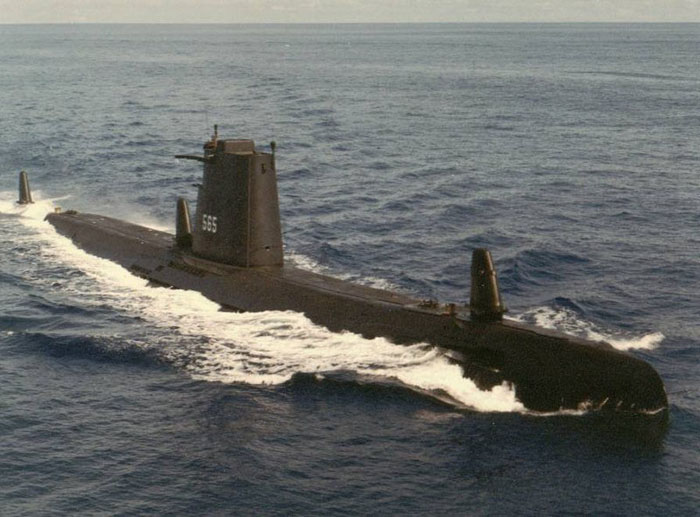
Following her sea trials and shakedown cruise to the British West Indies, post-shakedown fixes in Portsmouth she crossed the Panama canal for HP Pearl Harbor on 1 December 1952 afte a stop at San Diego.
West Pacific Service
In 1953 she was training in the Hawaiian Islands and became target for advanced ASW tactics. January 1954 saw her for a first WestPac tour with teh 7th Fleet in Far East waters in exercises and ports visits. Bacck to Pearl she had an overhaul. By March 1955 she visited Tahiti in French Polynesia. Next she returned with the 7 Fleet, stopping at Hong Kong, Kaohsiung in Taiwan, Guam, Yokosuka, Manila until May 1956.
In April 1957 to ctober 1957 she had another overhaul (OVL) followed in November by a new shakedown to Tahiti. Back to the western Pacific for routine training, port visit and back in June 1958 she was the first of the class awarded the conveted Battle “E” for SubRon 1. By November she was in maintenance and by June the next year she was assigned to SubRon 7 and by July she made another Far East tour, in ASW practice, fleet exercises and back HP in early 1960, she entered the Naval Shipyard for her major OVL, until late August followed by refresher training and training off the Hawaiian Islands.
By late March 1962 she had a battery renewal and resumed operations by late April, leaving on 22 May Pearl Harbor to join the 7th Fleet and toured Japan, Yokosuka, Sasebo, Hakodate, Naha, Okinawa. She was back in Pearl on 7 November. By December 1962, she was prepared and she made another westPac from 15 January 1963, six-month, visited Osaka abd back home on 15 July. By April 1964 she started a major overhaul. This was the last time. War was looming on the horizon.
Vietnam War
The summer of 1964 saw her back around Pearl Harbor and after the Gulf of Tonkin Incident she was prepared and rushed to the Far East in November, called to make two tours of duty in Vietnam in extended duration. She was back home by June 1965 until February 1966, earning a Navy Unit Commendation. In 1966, from 17 February to 29 August she multiplied patrols in the combat zone added to 7th Fleet exercises, port visits. Bac to Oahu she was in extended patrols until a major overhaul (17 months, PUFFS upgrade)
Afterwards, she had a refresher training and returned in operations around Pearl Harbor. 11 February 1969 saw her departing for the Far East and breif tour off Vietnam but otherwise peacetime deployment, back on 14 August for training routine. She was back for a 9th westPac from 1 April 1970, making a brief tour off Vietnam and remainder wit the 7th Fleet for training, back to Pearl on 21 October, followed by an overhaul completed on 1 June 1971.
Homeported to San Diego
After her overhaul she departed Pearl Harbor for the US West Coast and her new homeport of San Diego, stopping also in Portland and Vancouver. Late June and the summer saw her training along the southern California coast. She made however another WestPac TOD, notably to Korea, Chinhae and Pusan for combined operations with South Korean Navy, visiting Taiwan for bilateral ASW exercises with the ROCN. She was back at San Diego on 28 April 1972. She entered Hunters Point Naval Shipyard for a short overhaul and resumed local operations. By 16 February 1973 she departed for her 11th 7th Fleet WestPac. She also trained woth the South Korean and Republic of China navies as well later units of the Japanese Maritime Self Defense Force and back to San Diego on 14 August. Later off Californian she took part in a submarine against submarine, hunt also firing live torpedoes until the end of 1973 and early 1974.
On 14 June 1974 she received another OVL at Mare Island, until July 1975. After sea trials and stopping at Seattle for the 1975 Sea Fair she trained off the Pacific northwest and back to to San Diego on 28 August. She served later as school ship for prospective commanding officers, until early April 1976. She returned later to the 7th Fleet and bilateral exercises with South Korea and the SEALs, USMC, witj South Korean naval personnel and back on 8 September for a new routine off southern California.
On 6 September 1977 she was transferred to the Atlantic Fleet. On her way she stopped at Cartagena (Colombia), Miami, Savannah and arrived at her new HP New London on 15 October. By November she trained with Iranian Navy personal for a planned transfer, later cancelled. 1978 saw her in a six-week Caribbean cruise and ReadEx 1–78 followed in July by an extended overhaul at Philadelphia to be handed over as IS Nahang. Decommissioned on 27 June 1980 she was eventually cannibalized for maintaining the remaining Tang class boats, notably those on foreign service. She was stricken on 15 July 1983, sold in November 1984 for BU.
 USS Trout SS-566
USS Trout SS-566
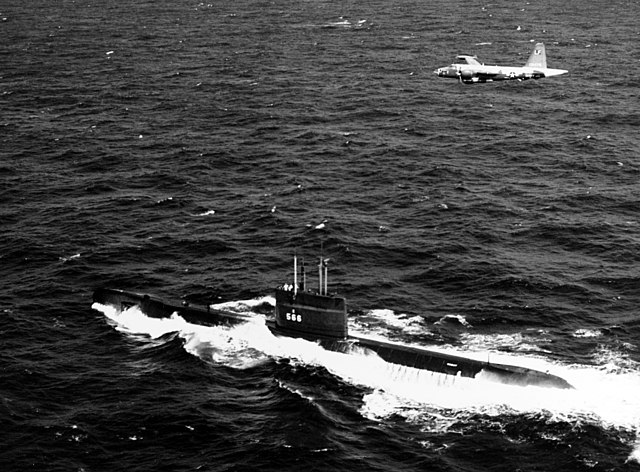
USS Trout was commissioned on 27 June 1952 and started service after shakedown and trials, with the Atlantic Fleet service, homeported to New London, Connecticut, SubRon 10 until 1959. A routine of readiness operations and ASW drills with the Atlantic and NATO fleets spanned years, with areas from North Atlantic to the Caribbean, sonar evaluation tests and submerged simulated attacks. She ventured also in Arctic waters with USS Harder, making a submerged 268 nautical miles (496 km; 308 mi) under pack ice off Newfoundland, Canada, setting a record for the time, later pulverized by USS Nautilus.
In August 1959, Trout was homeported to Charleston, joining subron 4, and making a first tour of duty in the Mediterranean from September 1959, with the 6th Fleet. In December 1959 while back she detoured to Bergen for the 50th anniversary celebrations for the birth of the Royal Norwegian Navy’s submarine arm.
In February 1960 she became a testbed for the Bureau of Ships shock tests. Later in home waters she won a first Battle Efficiency Award in 1961. In early 1963, she served with theOperational Test and Evaluation Force followed by a six-month overhaul at Charleston, starting in July 1963.
She will made afterwards three more Mediterranean deployments alternated with east coast/Caribbean Sea exercizes.
In July 1970, she was reassigned to the Pacific Fleet, homeported to San Diego, and making two WestPac tours in 1972 and 1975, notably for ASW exercises with the USN, ROKN, and ROCN. The remainder were spent off the Southern California coast and took part in weapons tests in the Pacific Northwest, from Puget Sound.
On 29 January 1976 she took part in the movied “submarine USS Neptune” and was featured in the opening credits of the 1978 movie Gray Lady Down.
On 1 December 1976 she was homeported last to Philadelphia and in 1977-1978 went through a, extensive overhaul for a planned transfer to the Iranian Navy. She was provisionally hoemported to New London for trials, refresher and training with Iranian personal. This program was completed on 19 December 1978 she was decommissioned, stricken and transferred. As she was officially part of the Imperial Iranian Navy she became IIS Kousseh (SS 101) (“Shark”), and the Iranian crew boared her after the ceremony at New London in December 1978, however while they were working out for effectively delivery, by March 1979 the Iranian Revolution caught her in a twist of fate. Her crew was repatriated to Iran, the program was terminated and the submarine, not without any owner by the USN by default, was returned to Philadelphia until financially the situation was resolved with Iran, and she was transderred back to te USN… by 1992.
She was sold to the Program Executive Office for Undersea Warfare, in 1994. Towed by USS Puma, moored at Pier 2, NAS Newport (Rhode Island) she was taken over officially by the Naval Air Warfare Center Aircraft Division, Key West Detachment to be targeted by various Naval Air Systems, and converted as remotely controlled submersible sonar target ship, and underwater acoustic target. When the program was complete, many years later, what was now the oldest submarine which was not a maritime museum, was towed to the Naval Inactive Ship Maintenance Facility at Philadelphia. Preservation efforts never succeed due to money lacking. So by May 2008 she was purchased at scrap value by Esco Marine of Brownsville in Texas and completely scrapped by 27 February 2009.
 USS Gudgeon SS-567
USS Gudgeon SS-567
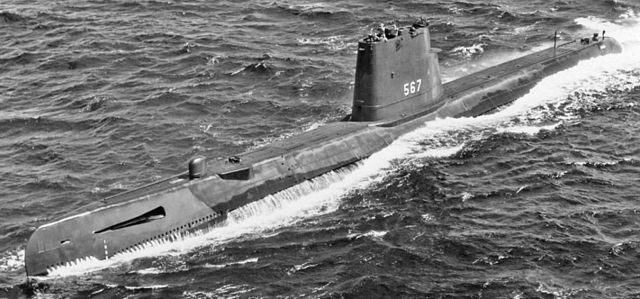
USS Gudgeon was commissioned on 21 November 1952 (Robert M. Carroll in command). She became the first US submarine to circumnavigate the globe, further reinforcing the image of the Tang class in general as a landmark in USN history. After her sea trials and shakedown, she was assigned to the Pacific fleet, and homeported to Pearl Harbor, SubRon 1, SubDiv 1 by July 1953. Training went on until 11 April 1954 and she returned on the West coast for advanced ASW exercises up to and beyond the Washington coast. She was rebuilt at Mare Island and she was back at Pearl Harbor on 9 March 1955. Departing on 21 July 1955 she made the first of her 5 WestPac TODs. She stopped at Yokosuka, Formosa (Taiwan), Hong Kong, Manila, Guam and back on 30 January 1956. She had a new overhaul, and took part in “spec ops”, followed by training on the West Coast took.
She left Pearl on 8 July 1957 for her groundbreaking around the world cruise, now promoted as flagship Pacific sub fleet, with navigator Lt. Leon L. Stine, Jr. She trained off Yokosuka and reall departed from there on 26 August 1957, making a six months crossing through Asia, Africa European ports and back to much fanrare at Pearl Harbor 21 February 1958 after covering 25,000 miles (40,000 km).
August 1957 saw her detected by the Soviet Navy off Vladivostok, just outside the 3-mile (US) territorial waters limit, inside the 12-mile limit (Soviet one), and this was considered a grave “povocation” act by Moskow. She was the the first US sub forced to the surface in the Cold War. She went next into an extensive overhaul, and mutiplied ASW and special operations, then making three WestPac in 1959, 1961, and 1963, generally also touring Japan for exercizes with the 7th Fleet, also spending time at Subic Bay, and off Hong Kong. In 1960 and 1962 however she stayed in mainland waters for the usual ASW exercizes between California and Washington.
Back to Pearl Harbor on 1 August 1963, she sailed again by late November to San Francisco, and Mare Island for her last and largest upgrade modernization, converted to the Passive Underwater Fire Control Feasibility System (PUFFS) installation, complete by April 1967 so that she was able to return to Pearl that year.
She never was sent to Vietnam and went on with her usual training routine until reclassified aa “miscellaneous auxiliary submarine” (AGSS-567), later SSAG-567 by November 1979. She was decommissioned on 30 September 1983, stricken 6 August 1987 and sold later for BU.
 USS Harder SS-568
USS Harder SS-568

Harder was commissioned on 19 August 1952.
After shakedown off Newport, she made a 1000 mile (1600-km) submerged run from New London to Nassau in the Bahamas snorkeling. Fleet operations off New London started from June 1953. She made her first overseas deployment, to the British Isles but underway sufferred a lot from her new Type 3 Fairbanks type 3 engines. So much so that she was found without power by August 1953, on the east coast of Ireland and she was towed by USS Tringa over 2100 miles (3400 km) back to New London for repairs.
Afterwards she took part in intensive training operations with the Atlantic Fleet, also with NATO fleets. From Newfoundland to the Caribbean Sea she mutiplied sonar tests and took part in advanced ASW tactical exercises, submerged simulated attacks and by March 1959 ex. SUBICEX, cruising 280 miles (450 km) below Newfoundland, a record for any conventional submarine.
Next she was homeported to Charleston, arriving on 17 November and assigned to SubRonn 4. Resuming Atlantic-Caribbean routine, she departed on 24 May 1961 for a European western coast and Mediterranean first TOD. She entered Bremerhaven on 9 June for ASW operations with the Bundesmarine. Next she entered Holy Loch in Scotland, on her ay to Gibratlar, Rota in Spain. There she was involved in peace-keeping operations with the 6th Fleet and back on 28 August.
After ASROC tests she was overhauled at Charleston from October 1962 to April 1963 and returned to routine exercises off the Atlantic Coast and Caribbean Sea two and a half years, hard at work to perfect her tactics and used as target by destroyers.
On 22 October she had a new overhaul and modernization (PUFFS upgrade), until 1967, and she resumed her Atlantic routine. Here the records stops, until she was decommissioned on 31 January 1974, struck from the Naval Vessel Register on 20 February 1974, and sold to Italy. Recom. 18 August 1974 after transfer to Italy as Romeo Romei, then decommissioned again, scrapped in 1988.
Links
wadehamptoncamp.org/tang.html
navsource.org/archives/08/08563.htm
navweaps.com/
navypedia.org/
en.wikipedia.org – Tang-class_submarine
plans on researcheratlarge.com/
commons.wikimedia.org Tang_class_submarines CC photos
Videos
Model Kits
Scalemates Tang class Onlt two models, Tang by OKB Grigorov 1:700 and USS Gudgeon SS-567 by Blue Ridge Models 1:350.
au.super-hobby.com/ USS-Tang-class-submarine.html

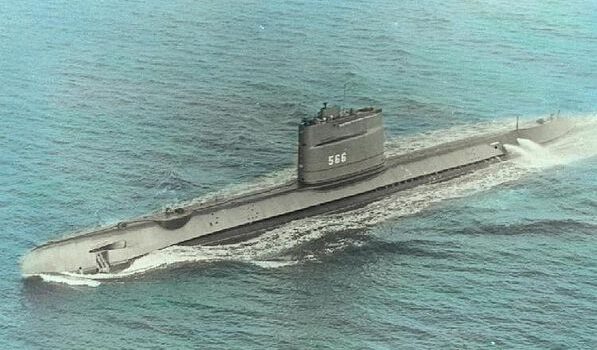









 Latest Facebook Entry -
Latest Facebook Entry -  X(Tweeter) Naval Encyclopedia's deck archive
X(Tweeter) Naval Encyclopedia's deck archive Instagram (@navalencyc)
Instagram (@navalencyc)





 French Navy
French Navy Royal Navy
Royal Navy Russian Navy
Russian Navy Armada Espanola
Armada Espanola Austrian Navy
Austrian Navy K.u.K. Kriegsmarine
K.u.K. Kriegsmarine Dansk Marine
Dansk Marine Nautiko Hellenon
Nautiko Hellenon Koninklije Marine 1870
Koninklije Marine 1870 Marinha do Brasil
Marinha do Brasil Osmanlı Donanması
Osmanlı Donanması Marina Do Peru
Marina Do Peru Marinha do Portugal
Marinha do Portugal Regia Marina 1870
Regia Marina 1870 Nihhon Kaigun 1870
Nihhon Kaigun 1870 Preußische Marine 1870
Preußische Marine 1870 Russkiy Flot 1870
Russkiy Flot 1870 Svenska marinen
Svenska marinen Søværnet
Søværnet Union Navy
Union Navy Confederate Navy
Confederate Navy Armada de Argentina
Armada de Argentina Imperial Chinese Navy
Imperial Chinese Navy Marinha do Portugal
Marinha do Portugal Mexico
Mexico Kaiserliche Marine
Kaiserliche Marine 1898 US Navy
1898 US Navy Sovietskiy Flot
Sovietskiy Flot Royal Canadian Navy
Royal Canadian Navy Royal Australian Navy
Royal Australian Navy RNZN Fleet
RNZN Fleet Chinese Navy 1937
Chinese Navy 1937 Kriegsmarine
Kriegsmarine Chilean Navy
Chilean Navy Danish Navy
Danish Navy Finnish Navy
Finnish Navy Hellenic Navy
Hellenic Navy Polish Navy
Polish Navy Romanian Navy
Romanian Navy Turkish Navy
Turkish Navy Royal Yugoslav Navy
Royal Yugoslav Navy Royal Thai Navy
Royal Thai Navy Minor Navies
Minor Navies Albania
Albania Austria
Austria Belgium
Belgium Columbia
Columbia Costa Rica
Costa Rica Cuba
Cuba Czechoslovakia
Czechoslovakia Dominican Republic
Dominican Republic Haiti
Haiti Hungary
Hungary Honduras
Honduras Estonia
Estonia Iceland
Iceland Eire
Eire Equador
Equador Iran
Iran Iraq
Iraq Latvia
Latvia Liberia
Liberia Lithuania
Lithuania Mandchukuo
Mandchukuo Morocco
Morocco Nicaragua
Nicaragua Persia
Persia San Salvador
San Salvador Sarawak
Sarawak Uruguay
Uruguay Venezuela
Venezuela Zanzibar
Zanzibar Warsaw Pact Navies
Warsaw Pact Navies Bulgaria
Bulgaria Hungary
Hungary

 Bundesmarine
Bundesmarine Dutch Navy
Dutch Navy Hellenic Navy
Hellenic Navy Marina Militare
Marina Militare Yugoslav Navy
Yugoslav Navy Chinese Navy
Chinese Navy Indian Navy
Indian Navy Indonesian Navy
Indonesian Navy JMSDF
JMSDF North Korean Navy
North Korean Navy Pakistani Navy
Pakistani Navy Philippines Navy
Philippines Navy ROKN
ROKN Rep. of Singapore Navy
Rep. of Singapore Navy Taiwanese Navy
Taiwanese Navy IDF Navy
IDF Navy Saudi Navy
Saudi Navy Royal New Zealand Navy
Royal New Zealand Navy Egyptian Navy
Egyptian Navy South African Navy
South African Navy






























 Ukrainian Navy
Ukrainian Navy dbodesign
dbodesign